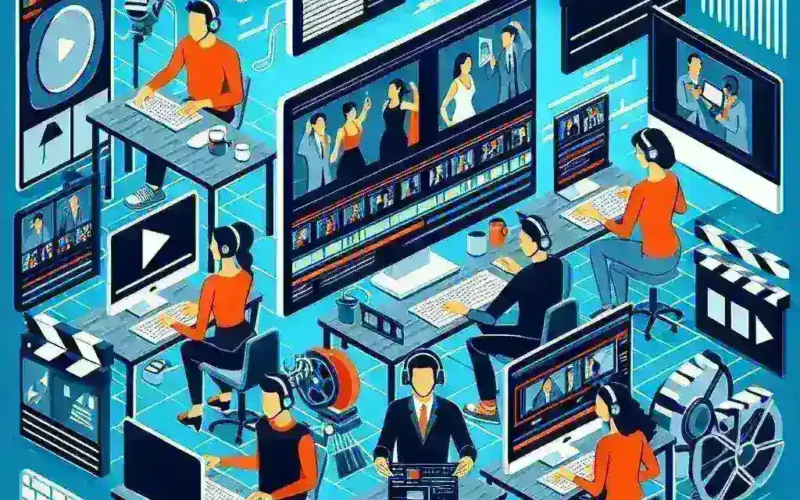The digital landscape has dramatically shifted towards mobile-first content consumption, making vertical video editing an essential skill for modern content creators. With platforms like TikTok, Instagram Stories, and YouTube Shorts dominating the social media sphere, understanding how to efficiently edit vertical videos on desktop has become crucial for maintaining professional quality while meeting audience expectations.
Understanding Vertical Video Format
Vertical videos, also known as portrait-oriented content, utilize a 9:16 aspect ratio that perfectly fits mobile screens. This format has revolutionized content creation by providing an immersive viewing experience that eliminates the need for users to rotate their devices. The popularity of vertical content stems from its ability to capture full attention and create more engaging visual narratives.
Desktop editing offers significant advantages over mobile editing applications, including superior processing power, larger screens for precise editing, and access to professional-grade software with advanced features. While mobile apps provide convenience, desktop solutions deliver the precision and flexibility required for high-quality content production.
Essential Desktop Software for Vertical Video Editing
Professional Video Editing Applications
Adobe Premiere Pro stands as the industry standard for professional video editing. Its comprehensive timeline interface and advanced color correction tools make it ideal for complex vertical video projects. The software supports custom sequence settings, allowing editors to create 9:16 projects with precise control over resolution and frame rates.
Final Cut Pro X offers Mac users an intuitive editing experience with powerful magnetic timeline functionality. Its optimized performance on Apple hardware makes it particularly suitable for handling high-resolution vertical content without compromising system performance.
DaVinci Resolve provides a free yet professional-grade solution that combines editing, color correction, and audio post-production capabilities. Its node-based color grading system offers unprecedented control over visual aesthetics, making it perfect for creators seeking cinematic quality in their vertical content.
User-Friendly Alternatives
For beginners or those seeking streamlined workflows, applications like Filmora and Adobe Premiere Elements offer simplified interfaces without sacrificing essential features. These programs include preset vertical video templates and automated optimization tools that accelerate the editing process.
Setting Up Your Desktop Workspace
Creating an efficient editing environment begins with proper project configuration. Start by establishing a new project with 1080×1920 resolution (or 2160×3840 for 4K vertical content) to ensure optimal output quality. Configure your timeline to match the vertical aspect ratio, preventing any cropping or scaling issues during export.
Organize your workspace by customizing panel layouts to accommodate vertical content preview. Most professional editing software allows users to resize and reposition preview windows, enabling comfortable viewing of portrait-oriented footage while maintaining access to essential editing tools.
Import and Organization Strategies
Efficient file management forms the foundation of successful vertical video editing. Create dedicated folders for raw footage, audio files, graphics, and project files to maintain organization throughout the editing process. When importing content, pay careful attention to file formats and codecs to ensure compatibility and optimal performance.
Consider transcoding footage to proxy media for smoother editing experience, especially when working with high-resolution vertical content. This technique allows for real-time playback and editing while preserving original file quality for final export.
Core Editing Techniques for Vertical Content
Composition and Framing
Vertical video editing requires a fundamental shift in compositional thinking. Unlike traditional horizontal content, vertical videos emphasize height over width, creating opportunities for unique storytelling approaches. Focus on centering subjects within the frame and utilizing the full vertical space to create visually compelling narratives.
When editing existing horizontal footage for vertical output, strategic cropping becomes essential. Identify the most important visual elements and position them within the vertical frame while maintaining story continuity. Consider using zoom and pan techniques to guide viewer attention throughout the sequence.
Text and Graphics Integration
Vertical videos provide ample space for text overlays and graphic elements. Position titles and captions in areas that don’t obstruct key visual content, typically in the upper or lower thirds of the frame. Ensure text remains readable across various mobile devices by using appropriate font sizes and high contrast color schemes.
Graphics and animations should complement the vertical format rather than compete with it. Design elements that flow naturally with the portrait orientation, utilizing the height advantage to create dynamic visual progressions.
Audio Optimization for Vertical Content
Audio quality remains paramount regardless of video orientation. Desktop editing software provides superior audio editing capabilities compared to mobile applications, allowing for precise sound design and mixing. Implement noise reduction, equalization, and compression to ensure professional audio quality that matches your visual content.
Consider the mobile viewing environment when mixing audio levels. Many vertical videos are consumed with headphones or in noisy environments, requiring careful attention to dialogue clarity and background music balance.
Color Correction and Visual Enhancement
Desktop editing platforms excel in color grading and visual enhancement capabilities. Utilize color wheels, curves, and secondary color correction tools to create consistent visual aesthetics throughout your vertical content. Pay particular attention to skin tones and ensure colors remain vibrant and engaging across different mobile displays.
Apply appropriate sharpening and noise reduction filters to compensate for mobile viewing conditions. Consider that vertical content often appears smaller on desktop screens during editing, making it essential to preview your work on actual mobile devices or use device simulation tools.
Advanced Editing Workflows
Multi-Camera Editing
Desktop software enables sophisticated multi-camera editing workflows for vertical content production. Synchronize multiple camera angles and create dynamic sequences that maintain viewer engagement throughout the vertical viewing experience. This technique proves particularly valuable for interview content, tutorials, and performance videos.
Motion Graphics and Animation
Leverage desktop computing power to create complex motion graphics and animations optimized for vertical viewing. Use keyframe animation to create smooth transitions and engaging visual effects that enhance storytelling without overwhelming the content.
Export Settings and Platform Optimization
Different social media platforms require specific technical specifications for optimal vertical video performance. Configure export settings to match platform requirements, including resolution, bitrate, and codec specifications. Instagram Stories, TikTok, and YouTube Shorts each have unique optimization parameters that affect video quality and engagement metrics.
Create multiple export presets for different platforms to streamline your publishing workflow. Consider creating both standard and high-quality versions to accommodate varying internet connection speeds and device capabilities.
Performance Optimization Tips
Desktop editing of vertical content can be resource-intensive, particularly when working with high-resolution footage. Optimize system performance by closing unnecessary applications, using proxy media for editing, and rendering preview files for complex sequences. Regular project file cleanup and media management prevent system slowdowns and ensure smooth editing experiences.
Invest in adequate storage solutions, as vertical video projects often require significant disk space for raw footage, project files, and export renders. Consider using external drives or cloud storage for archival purposes while maintaining active projects on fast internal storage.
Collaboration and Version Control
Desktop editing platforms facilitate collaboration through project sharing and version control features. Utilize cloud-based project sharing when working with teams, ensuring all collaborators have access to current project files and media assets. Implement consistent naming conventions and backup strategies to prevent data loss and maintain project integrity.
Future-Proofing Your Vertical Video Skills
The vertical video landscape continues evolving with new platform features and technical requirements. Stay current with industry trends by following platform updates, experimenting with new editing techniques, and continuously refining your desktop editing workflows. Consider investing in ongoing education through online courses and professional development opportunities.
As virtual and augmented reality technologies advance, vertical content creation may expand beyond traditional social media applications. Developing strong desktop editing skills provides a foundation for adapting to future content creation requirements and emerging platforms.
Conclusion
Mastering vertical video editing on desktop platforms opens unlimited creative possibilities for content creators across all skill levels. By understanding the unique requirements of portrait-oriented content and leveraging the power of professional desktop editing software, creators can produce engaging vertical videos that stand out in today’s competitive digital landscape. The combination of technical proficiency, creative vision, and strategic platform optimization creates the foundation for successful vertical content that resonates with modern mobile-first audiences.






